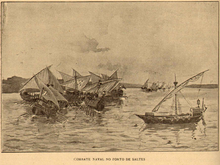| Battle of Saltes Island | |||||||
|---|---|---|---|---|---|---|---|
| Part of the Third Ferdinand War | |||||||
 Illustration by Alfredo Roque Gameiro | |||||||
| |||||||
| Belligerents | |||||||
|
|
| ||||||
| Commanders and leaders | |||||||
| João Afonso Telo | Fernando Sánchez de Tovar | ||||||
| Strength | |||||||
| 23 galleys | 17 galleys | ||||||
| Casualties and losses | |||||||
| 22 galleys and their crews captured | Minimum | ||||||
| Third Ferdinand War | |
|---|---|
| Ferdinand Wars | |
|---|---|
The naval Battle of Saltes Island or Battle of Saltes (Spanish: Batalla de la Isla Saltés) took place on 17 July 1381, off Saltes Island, between the Crown of Castile and the Kingdom of Portugal during the Third Ferdinand War. The Castilian fleet commanded by Don Fernando Sánchez de Tovar defeated decisively the Portuguese fleet led by João Afonso Telo. The result of the battle was the destruction of the naval offensive capability of Portugal, achieving the Castilian naval supremacy in the Atlantic Ocean.
Background
Following the death of Peter I of Castile, Ferdinand I of Portugal declared war on the Kingdom of Castile for possession of the Castilian throne. This series of conflicts were known as the Ferdinand Wars. In 1381, breaking the Treaty of Santarem (1373) which brought peace to the second war, Ferdinand I retaliated against Castile, thus initiating the Third Ferdinand War. For this, he signed an alliance with the young Richard II of England. John of Gaunt, Duke of Lancaster, also had claims to the Castilian throne since 1371 and seeing in this deal a means of enforcement of his cause, sent about 2,000 English soldiers under the command of the Earl of Cambridge to Lisbon to support a Portuguese incursion into the Castilian territory.
To prevent the English contingent being intercepted at sea by the navy of Castile, the Portuguese monarch planned a naval blockade. In mid-July 1381, a Portuguese fleet under the command of João Afonso Teles de Menezes, 6th Count of Barcelos, sailed from Lisbon towards the mouth of the Guadalquivir river to prevent the passage of the Castilian fleet, which was anchored in Seville. At the same time, the fleet of Admiral Fernando Sánchez de Tovar sailed from its base in Seville, heading out to the Portuguese coasts. On 17 July, sailing in opposite directions, the two fleets sighted each other off the Algarve.
Battle of the Saltes Island
After assessing the situation, Castilian Admiral Fernando Sánchez de Tovar considered victory very unlikely under the circumstances and ordered the fleet to tack and return to port. His Portuguese counterpart saw an opportunity to beat the rival, and began pursuit of the Castilian fleet. De Tovar ordered to his men to row at a fast pace, forcing his Portuguese pursuers to match the effort to try to overcome the fleet. The different speeds at which they advanced increased the distance between the Portuguese ships, breaking their formation.
After about two hours, exhaustion, thirst and the heat of summer took their toll on the Portuguese rowers, and many of their ships were left behind. Eight of them, the vanguard of the Portuguese fleet, attacked the small island of Saltés and destroyed the property of the fishermen in the vicinity. Seeing that the Portuguese had fallen into his trap, de Tovar launched his ships against the enemy in compact formation, and easily captured the Portuguese galleys. The rest of the Portuguese fleet approached in disarray one by one and were captured by the Castilians without difficulty. Eventually, only one of the 23 Portuguese galleys avoided capture.
Aftermath


Admiral Fernando Sánchez de Tovar entered triumphantly with his 22 galleys captured in the port of Seville, with great joy of its inhabitants. This fact allowed the English to dock in Lisbon without problems. Later, the English men of the Duke of Lancaster, arranged their boats to face off against the fleet of Sánchez de Tovar, but knowing that he had returned to Seville, the English ships returned to England, leaving in Lisbon to the English land forces.
The resounding victory of Don Fernando Sánchez de Tovar had obvious implications for the Third Ferdinand War. Annulled the naval offensive capability of Portugal, achieving the Castilian naval supremacy in the Atlantic Ocean. That year, the Portuguese could not build more fleets against Castile, who, in turn, did not need to do the same, and the Castilians exercised an effective control of the sea. Therefore, the battle ended the naval Portuguese campaign of 1381.
The effects of the Portuguese defeat also felt in the following year, when the Kingdom of Portugal had to face, militarily weaker than usual, a vigorous attack by sea and land from the Crown of Castile. The Castilians came to the gates of Lisbon, forcing the King of Portugal to sign peace in August with John I of Castile, by the Treaty of Elvas.
See also
Notes
- ^ Fernández Duro p.144
- ^ Fernández Duro p.145
- ^ Lopes 347–353
- ^ Quintella p.37
- ^ Pereira p.141
- ^ Batista González. España estratégica Vol.6
- ^ Fernández Duro 144–145
References
- (in Spanish) Cervera Pery, José. El poder naval en los reinos Hispánicos: la marina de la Edad Media. Madrid (1992) ISBN 84-7140-291-2
- (in Spanish) Condeminas Mascaró, Francisco. La Marina militar Española. Málaga (2000) ISBN 84-930472-4-4
- (in Portuguese) Lopes, Fernão. Crónica do Senhor Rei D. Fernando Nono Rei de Portugal. Livraria Civilização. Porto (1966)
- (in Spanish) Fernández Duro, Cesáreo. La Marina de Castilla. Madrid (1995) ISBN 978-84-86228-04-0
- (in Portuguese) Quintella, Ignacio da Costa. Annaes da Marinha Portugueza. Academia Real das Sciencias. Lisboa (1839)
- (in Portuguese) Pereira, António Rodrigues. História da Marinha Portuguesa. Escola Naval. Lisboa (1983)
- (in Spanish) Batista González, Juan. España estratégica. Guerra y diplomacia en la historia de España. Madrid (2007) ISBN 978-84-7737-183-0
37°15′N 6°57′W / 37.250°N 6.950°W / 37.250; -6.950
Categories: